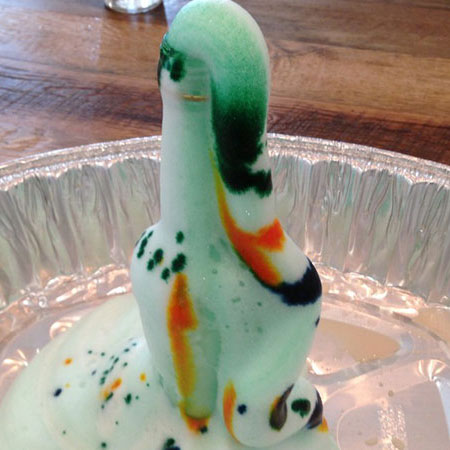 Photo from PBS Kids for Parents.
Photo from PBS Kids for Parents.
Foam Fountain
- Easy
- Messy
- 15 Minutes
- Indoor or Outdoor
You Will Need
12 or 16 oz empty plastic bottle
Hydrogen peroxide (3% solution is what most people have in their homes. You can use 6% available at beauty supply stores for a bigger blast!)
Food coloring
Liquid dish soap
Dry yeast packet
3 tablespoons warm water
Funnel
Liquid measuring cup
Large baking sheet
Safety goggles
Gloves
Directions
- Ask your young scientist to observe the dry yeast. What do they notice? Do they think the yeast is alive? Why or why not?
- Add 3 tablespoons of warm water to the glass measuring cup. Add the dry yeast to the warm water and mix for about 30 seconds. As your scientist to observe what happens to the yeast in the water - what do they see? What is going on in there?
- Meanwhile, place the bottle in the middle of the baking sheet. (The experiment will overflow from the bottle, so ensure your baking sheet is large enough to catch a spill!)
- Hydrogen peroxide can irritate the eyes and skin, so put on your gloves and safety goggles. Pour about ¾ cup of hydrogen peroxide into the bottle.
- Add a few drops of food coloring.
- Add a pretty big squirt of dish soap into the bottle (about 1 tablespoon).
- When you’re ready… using the funnel, add about ½ of the yeast solution to the bottle and stand back! A thick gush of foam will flow out of the top of the bottle!
- Ask your scientist to put their hands near the foam and the bottle, do they feel any heat? How did that happen?
Note:
- Keep your gloves on when disposing of the foam. You can wash it down the drain because it will break down into water after all of the oxygen is released.
Experiment Extensions
- Want more foam? Hair salons and beauty supply stores carry 6% hydrogen peroxide. Try the activity again with this higher concentration - have a blast!
- Or, increase the amount of yeast added to the bottle. Does it affect the reaction?
How it works
What’s going on in there? First - the yeast! Yeast is an amazing single-celled organism. Explain to your young kids that the dry yeast they observed at the beginning of the experiment was sleeping. When the yeast was added to the warm water, it woke up!
The molecular structure of hydrogen peroxide is H2O2, which you may recognize as water with an extra oxygen atom. The yeast are hungry and start to decompose the structure of the hydrogen peroxide, stripping off the extra oxygen atom which is released as a gas. All that yeast mixing with all of that H2O2 releases a lot of oxygen bubbles all at once, which get trapped in the soap and creates an overflow of foam right out of the top of the bottle!
What about the heat? The reaction happens so quickly, that it also creates heat! This is called an exothermic reaction.
Key Words
- Yeast
- Tiny one-celled organisms
- Exothermic Reaction
- A chemical reaction where the substances reacting release energy as heat
